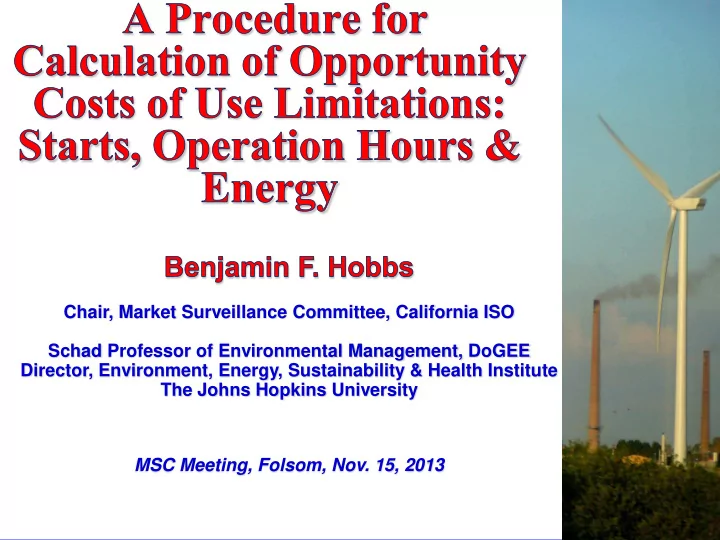

Chair, Market Surveillance Committee, California ISO Schad Professor of Environmental Management, DoGEE Director, Environment, Energy, Sustainability & Health Institute The Johns Hopkins University MSC Meeting, Folsom, Nov. 15, 2013
Question Addressed • What are the opportunity costs of starts , operation hours , and energy for quick-start thermal units that have monthly or other limits on one or more of those? • That is, how much profit (and, market surplus, assuming competitive conditions) is foregone if we use up one more start, run-hour, or MWh today? – One more start today could mean one less start later in the year, and a loss of benefit then – Likewise for one more operating hour, and one more MWh • Proposed use: as adders in values of proxy start-up cost, proxy minimum-load cost, and default energy bid used by LMPM
Assumptions • Limits on numbers of starts, operating hours, and/or MWh for a unit over some period (1 week ↔ 1 yr) – Defined as “season” • RTUC can be used to start-up or shut-down 15 minute prices relevant • Future distribution of 5 minute prices known – Can construct a representative time series of prices for remainder of month – Actual profitability can be approximated by deterministic SCUC – Not actually true: prices might be higher or lower than expected and are not perfectly known Ideal: stochastic programming (SDP; see Oren et al.) Could have multiple scenarios (hot/cool summer; major outages; etc.)
Basic Approach Solve over entire season • Decisions : timing of starts & shut-downs, and energy (& ancillary services) production by 15 minute interval • Objective: Maximize Gross Margin = [Revenues – Variable Costs] • Constraints: 1. Internal unit commitment, dispatch constraints: a) Energy: ramp limits, Pmin, Pmax b) Minimum shut-down and start-up times c) (Ancillary service capabilities) 2. Operating constraints: a) Total number of starts over season < NSTARTS b) Total number of operating hours over season < NHOURS c) Total energy over season < NMWH Opportunity Cost calculations: a) Decrease NSTARTS by 1 (or other number), and note ∆ Gross Margin Decrease NHOURS by 1, note ∆ GM b) c) Note shadow price on NMWH constraint
Example: Unit Commitment to Calculate GM 3 MW unit 24 hrs: Pmin = 1 MW, 2 variable blocks • $50 start up cost; $80/hr Pmin cost; 3 hr min down time • Variable cost block 1 $49/MWh; block 2 $69/MWh Price $/MWh Pmin Cost Block 2 Cost Block 1 Cost Hour Block 2 Optimal if 2 starts: Block 1 no start limit GM = Pmin $152 1 start: GM = $135
Optimal Starts over Season (7 days) Say: NSTARTS = 4, NHOURS = 2, NMWH = 50 for 1 week: What is optimal operation? GM by day day Total GM 152 80 105 = $337 Starts 2 1 1 = 4 Hours 11 5 9 = 25 hr MWh 21 13 16 = 50 MWh
NSTART Opportunity Cost Decrease NSTARTS from 4 to 3, reoptimize • • Red is decrease • Green is increase GM by day day Total GM 135 80 80 = $295 Starts 1 1 1 = 3 Hours 14 5 6 = 25 hr MWh 27 13 10 = 50 MWh GM Decrease = $337 - $295 = $42 opportunity cost of start
NHOURS Opportunity Cost Decrease NHOURS from 25 to 24, reoptimize • • Red is decrease • Green is increase GM by day day Total GM 152 72 108 = $332 Starts 2 1 1 = 4 Hours 11 4 9 = 24 hr MWh 21 11 18 = 50 MWh GM Decrease = $337 - $232 = $5 opportunity cost of operating hours
NMWH Opportunity Cost Use -1*shadow price from NHOURS constraint (= increase in • GM from ∆ NMWH = +1). Effect of ∆ NMHW = -1: • GM by day day Total GM 152 80 101 = $333 Starts 2 1 1 = 4 Hours 11 5 9 = 25 hr MWh 21 13 15 = 49 MWh GM Decrease = $337 - $333 = $4 opportunity cost of energy
Carrie Bentley, CAISO
Recommend
More recommend